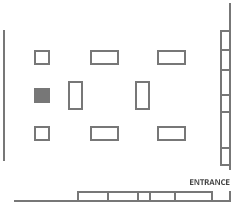 University Library
What She Said
University Library
What She Said
Part II: Women Together
Part III: Issue Spotlights
 University Library
What She Said
University Library
What She Said
Part II: Women Together
Part III: Issue Spotlights
In the 19th century, many women reformers drew on what they called the "conservation trilogy" of womanhood, the home, and the child to frame the preservation of natural resources as an extension of a woman's caregiving role. Women joined conservation groups in droves well into the early 20th century, focusing on national forest preservation and creation, watershed protection, bird and plant protections, forest fire laws, reforestation, and conservation research. Women also worked to address public health hazards that result from pollution of water, solid waste, smoke, and unsafe work environments through organizations such as the Sierra Club, the Audubon Society, and others.
While some engaged with environmental issues by joining existing conservation and women's organizations, other women increasingly formed grassroots organizations to address pollution, the encroachment of urban areas on open spaces, the protection of wildlife, clean water, toxic and nuclear waste, and more. In Los Angeles, many of these organizations worked closely with communities and local governments in shaping legislation, policies, and practices, playing an instrumental role in protecting the city's and state's environmental resources.
On display in this case are newsletters, agendas, study kits, and other resources that provide evidence of this work. These include evaluations and recommendations about strategies adopted to improve the air quality in Los Angeles in the late 20th century, agendas and essays around various issues having to do with toxic and nuclear waste in the city, and investigations of Los Angeles's water infrastructure, especially the impact of the city's water needs on other areas of California.
Case 3, Criminal Justice, is the tall case that's closest to the Gohstand Reading Room.
1
Newsletter, Facts & Issues, "A Congregation of Vapors," September 1970Dorothy Boberg Collection
2
"Analysis and Evaluation of Clean Environment Initiative," The Problem and Recommendations, American Association of University Women, February 1972Dorothy Boberg Collection
3
Forum Agenda, "Toxic Tragedies - Can They be Prevented?"League of Women Voters of Los Angeles Collection
4
Study Kit, Air Pollution - Environmental Quality Study, January 1971League of Women Voters of Los Angeles Collection
5
"Los Angeles Voter," February 1986League of Women Voters of Los Angeles Collection
6
Letter from Patricia Madueno, Chairwoman, Fort Mojave Indian Tribe, to Juana Beatriz Gutierrez, President, Mothers of East LA, March 29, 1996Juana Beatriz Gutiérrez Mothers of East Los Angeles Collection
7
"Forging a Public-Private Partnership Can Solve California's Hazardous Waste Crisis"Joy Picus Collection
8
Press Release, Councilwoman Joy Picus, January 16, 1985Joy Picus Collection
9
Minutes, League of Women Voters Los Angeles-Ventura Counties Water Committee, September 23, 1971League of Women Voters of Los Angeles Collection
10
Mono Lake: Partnership to Preserve NatureJuana Beatriz Gutiérrez Mothers of East Los Angeles Collection
11
"Analysis and Evaluation of Clean Environment Initiative," American Association of University Women, February 1972Dorothy Boberg Collection
12
Official Report, World Women's Congress for a Healthy Planet, November 1991Susan B. Nelson Collection
13
Board of Water and Power Commissioner Angel Echevarria at Mothers of East LA Press Conference, August 27, 1992Juana Beatriz Gutiérrez Mothers of East Los Angeles Collection
14
The Lead Tester KitJuana Beatriz Gutiérrez Mothers of East Los Angeles Collection
